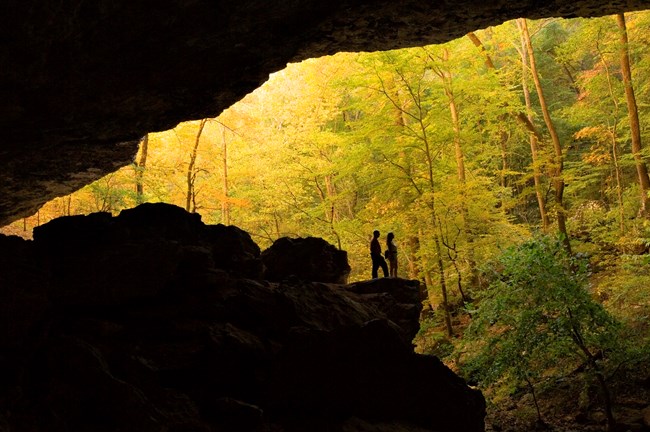|
Visit our keyboard shortcuts docs for details
Did you know that there are more than 500 caves that have been discovered at Buffalo National River? Crawl around underground with members of the Cave Research Foundation and discover what lies beneath the surface. Learn more: https://www.nps.gov/buff/learn/nature/cave.htm 
Arkansas Department of Parks and Tourism Karst TopographyThe Ozark Mountains are known to have one of the largest karst networks in the midwest United States. The Buffalo National River alone has more than 500 caves within its boundaries, making it one of the most cave-rich units in the National Parks. Karst systems are a type of topography that typically forms in contact with carbonate rock units of limestone and dolomite. Karst features begin to form as the calcium carbonate in the rock is dissolved by water, made slightly acidic from absorbing carbon dioxide in the atmosphere, decomposing organic material water comes in contact with, and the weathering of minerals in soils. This water percolates down from the surface or circulates underground into cracks and fissures of rock layers, dissolving the calcium carbonate present. These openings are widened by further dissolution, as well as abrasion as sediment is transported through them, hydraulic pressure, the freezing and melting of water, and even tree roots forcing their way into the spaces. Features develop at different rates, which depend on the amount, flow, and acidity of water.
Features characteristic of karst topography include caves, sinkholes, springs and seeps, and disappearing (losing) streams, all of which can be seen around Buffalo National River. Below ground, karst systems often form maze-like fissures and conduits through which water travels very quickly. Scientists can track the movement of water by using non-toxic dyes at the surface, usually after it has rained, and taking note of how and where the dye emerges in streams throughout the watershed because of these conduits. Dye tracing studies like this have been carried out at Buffalo National River and have shown connections between springs and streams that are not visible on the surface, but there is always more to study. Karst systems in the Buffalo River drainage are associated with the Boone Formation. The Boone Formation is composed of limestone of the Mississipian age, and has intermittent chert layers near the top and bottom of the formation. Most of the larger cave systems in this area are found in and near the upper and lower contacts of the Boone. However, some of the cave systems have passages that extend into the upper (Mississipian and Pennsylvanian) and lower (Ordovician) stratigraphic layers. To learn more about how the Ozarks formed and the geology of the Buffalo River Valley visit the park's Climate and Geology page. Cave Closures and White Nose SyndromeAll caves within the boundary of Buffalo National River are closed to recreational caving with the exception of: the caves in Lost Vally (Eden Falls Cave and Natural Bridge); the caves along the Panther Creek trail sytem at Buffalo Point (Panther Cave and Indian Rock House) are open to unrestricted recreational caving; Back O'Beyond cave and Silver Hill cave are open for guided interpretive tours only. These recretaional closures are due to White Nose Syndrome, a fungal disease that has decimated bat populations in the eastern United States in recent years. White Nose Syndrome (WNS) is caused by a fungus that attacks bats' wings, noses, and ears while they are in hibernation. The white-nose fungus depletes the bats' energy reserves and causes them to prematurely awake from hibernation. Early awakening and excessive movement ultimately lead to the death of most affected bats. The fungus is transferred extremely easily from bat to bat and by clothing and boots that have been exposed to the fungus. This is one reason why most caves and mines at Buffalo National River are closed to the public. To learn more about WNS visit the park's Bats and White-Nose Syndrome page. You can find additional geological information about the park on the NPS Fieldnotes page at https://nature.nps.gov/geology/parks/buff/index.cfm |
Last updated: May 31, 2023
